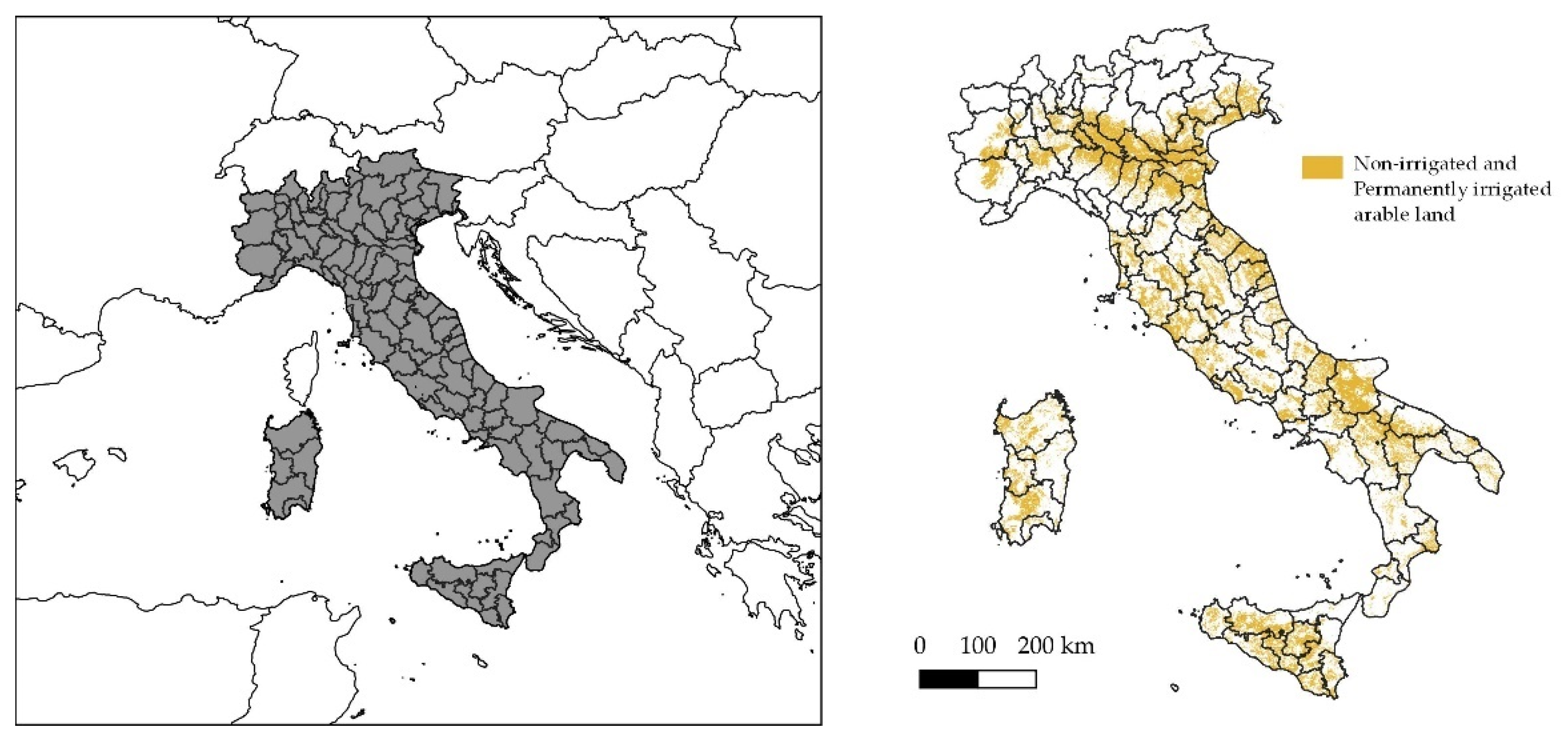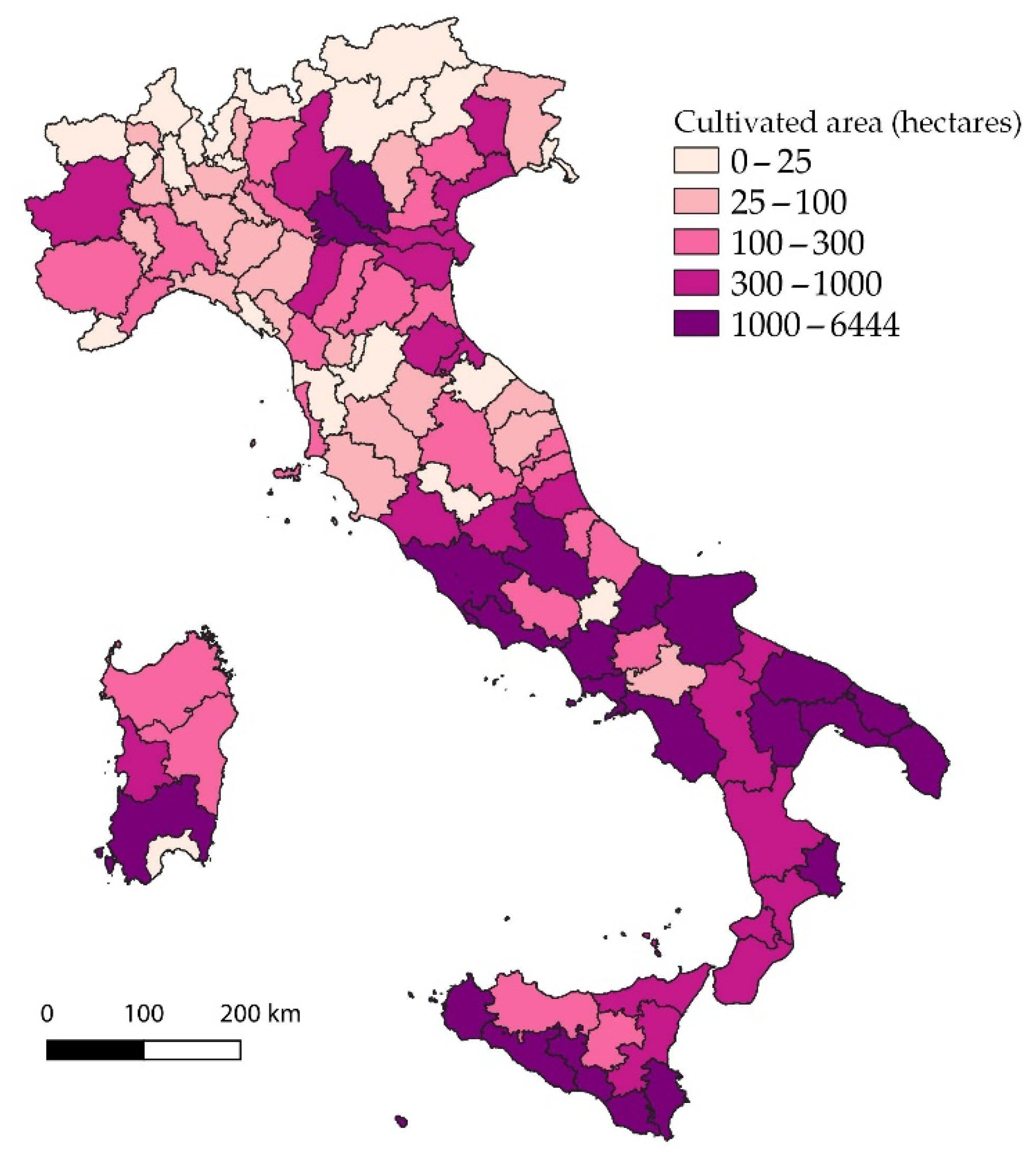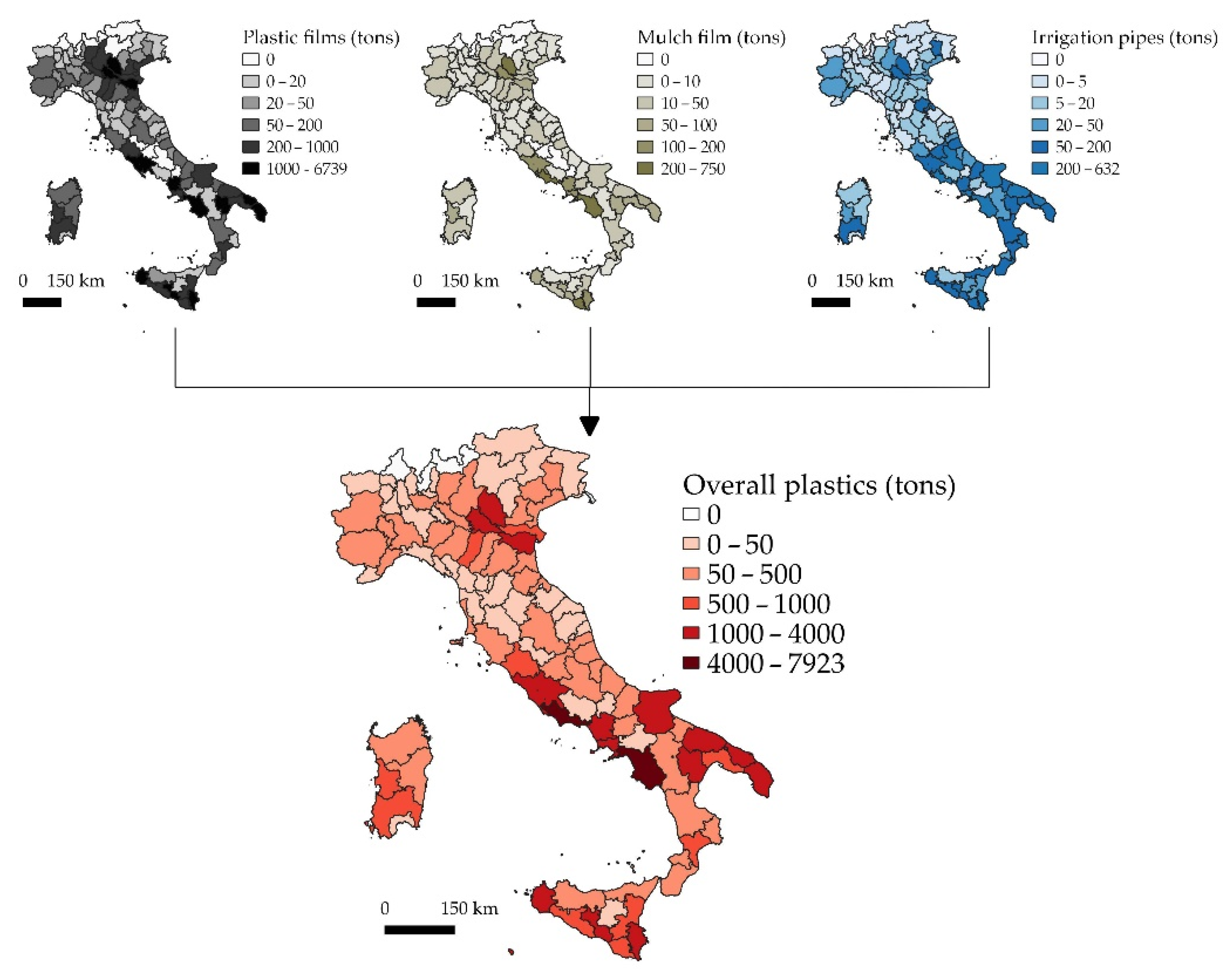1. Introduction
Soil represents one of the fundamental elements for any type of terrestrial ecosystem; it is an essential asset for human life. Ensuring the preservation/recovery of soil ecosystem health is one of the most important challenges that has emerged in recent decades. This is one of the key aspects of the Sustainable Development Goals and one of the objectives of the European Green Deal [
1,
2]. Among the many strategies implemented by various international organizations, the Soil Health Mission aims to ensure that, by 2030, 75% of soils are healthy and able to provide ecosystem services that are essential to human life [
3]. Indeed, the soil issue is cross-cutting and connected to the other objectives of the European Green Deal related to climate, biodiversity, pollution, agri-food system sustainability, and ecosystem resilience. Within the imagined strategy, one of the specific objectives is to protect the soil ecosystem from excessive plastic pollution [
4].
Plastic pollution is a global issue that also affects food security due to its presence in most aquatic and terrestrial ecosystems [
5]. This type of pollution is so ubiquitous that it was recently discovered in human blood [
6]. Since the 1960s, global production of plastics has increased 20-fold, exceeding 300 million tons in 2015; it is predicted to double in the next 20 years [
7,
8]. Therefore, it has become imperative to study and understand how this increase in plastics will impact severely compromised ecosystems. Many previous studies were conducted on the impacts of plastic pollution on aquatic ecosystems [
9], but little has been investigated so far on terrestrial habitats [
10,
11].
Agricultural activities are among the most important sources of plastic in the soil; they are often underestimated as they are difficult to quantify [
12,
13]. This is because agricultural productivity and sustainability are substantially influenced by the use of plastic polymers in various forms and structures. Their main benefits are that they are lightweight and cheap and, hence, can be used in very large volumes in agricultural activities [
14]. Mulch films, polymer-coated soil additives, seeds, greenhouses, polytunnels, and silage product packaging are made of plastic; they are used in almost all agricultural activities [
15].
As per the common agricultural policy [
16], one of the most important topics to be addressed is activating the sustainable management of plastics in agriculture, to reduce the negative impacts of the release of micro- and nanoplastics in the soil [
17]. The release of plastic residues into farmland and their influences on soil health and long-term crop production are still not clear (Zhang et al.). For example, one of the first analyses was by Phiel et al. [
18] in southeast Germany, where the macro- and microplastic pollution on agricultural fields were quantified with values of around 200 macroplastics (pieces/hectares) and between 0.34 and 0.36 microplastics (particles/kilogram of the dry weight of soil). A more recent case study was carried out in Taiwan [
19], where differences in the amounts of microplastics (12–117 items/m
2) were found between farmlands near the road (more than three times) compared to those more isolated.
The problem of plastic pollution in agriculture is linked not only to the large quantities used but also to poor and inefficient management at the farmland level and the level of competent authorities responsible for agricultural plastic waste (APW) [
8]. The lack or inefficiency of agricultural plastic waste management and recycling systems in most European countries means that illegal disposal practices often occur [
20,
21].
The first step toward proper management of APW and, therefore, reducing their environmental footprint, is to quantify them, i.e., to implement different post-use sustainable management actions. The techniques are different, but surely the most used methodologies are based on a GIS approach [
22,
23,
24].
In the present paper, to develop useful methodologies that realize the digital atlas of agricultural plastics, an inductive (i.e.,
bottom-up) approach is proposed based on statistical data and the relevant index of the potential use of plastic material for cultivated crops in a study area. This approach has the same general objective, but it is different from the deductive approach (i.e.,
top-down) presented in the first part of the work already published [
25], in which a deductive methodology was implemented by exploiting satellite index images and orthophoto classifications [
26]. In this case, the methodology is based on the analysis and processing of statistical data from the agricultural census based on a well-defined administrative scope. Data (in terms of hectares on the different crops examined) were correlated with data on the types and quantities of plastics used for the crops derived from questionnaires proposed to various producers and agricultural associations [
27]. In this way, it was possible to quantify potentially the APW amount in terms of weight (tons per year) for each administrative area considered. The data were processed in a GIS environment since, in addition to spatializing different types of geoinformation [
28], they allowed for rapid operations and conversions in an immediate manner [
29]. The approach adopted here is similar to the one used by Briassoulis et al. [
30], but the data (referred to Italy) were updated and calculated in more detail, with support from Italian experts on protected cultivations (farmer associations/organizations/cooperatives).
Therefore, in previous work [
25], an additional geomatics methodology is provided, which is accurate but at the same time easy to apply on a large-scale and in other administrative contexts, in order to realize (in the future) a complete atlas of plastics at a European scale, which can be used as a tool for planning and monitoring (at land level) the environmental footprint reductions of several agricultural activities. Indeed, the methodology, integrated with the work already proposed [
25], can be a tool to support public administration to estimate APW with some accuracy, with a reliable and spatially explicit database able to activate sustainable management strategies.
3. Results and Discussions
The most important and fundamental datum for the management of plastics involves the types of polymer used. From the survey and interviews, it emerged that films and sheets consist of:
- -
High-density polyethylene (PE-HD);
- -
Low-density polyethylene (PE-LD);
- -
Polyvinyl chloride (PVC).
Demonstrating the need to activate intelligent and geospatial management of plastics—most of the interviewees did not have a strategy for the storage of materials and, therefore, disposal was not organized. Waste management is a central issue in all works concerning plastic pollution in rural areas, so it is increasingly necessary to study and develop tools and methodologies to address these problems [
38].
Interviews were crucial because they allowed us to estimate the number of plastics that were impossible to detect remotely (via satellite or orthophotos) especially given their size, such as irrigation pipes or mulch, which, with the medium-resolution images commonly used for APW estimation [
25,
39], were impossible to classify. That being said, the analysis focused only on those crops for which it was possible to retrieve data from the sample of interviewees; therefore, the analysis may be considered only from a methodological point of view, since it does not yet include all crops grown in Italy. The calculated potential of APW represents only a proportion of the total agricultural plastic waste produced in Italy. This is because the flow of plastic products within the agricultural market is too scattered and, therefore, available data are extremely dispersed and often divergent. Once the GIS project is set up and the data are connected in .CSV format, it is possible to extrapolate all of the necessary data for a detailed analysis and for all of the following operations that can be useful for hypothetical waste management planning at the local and/or provincial level [
40].
The first result concerns the calculation of the areas cultivated with the crops examined in Italy in the year of analysis [
31]. In percentage terms, the most important crop that emerged from the ISTAT database was open-air fennel, which represented 28% of the total (
Table 3).
Therefore, based only on the chosen crops under examination, the APCoeff was calculated for each plastic product considered (
Table 4) and added up to obtain the total (APCoeff_tot). This value indicates the kg of plastic used each year in each m
2 of the crop. Since the value of the cultivated area is in hectares and the APCoeff is relative to m
2, a conversion was necessary. The complete scheme of individual plastic structure data for each crop is shown in
Appendix A (
Table A1).
From the APCoeff calculation, it emerges that the crops with the highest use of plastic recorded are melons and watermelons in the greenhouse, with 0.254 kg of plastic used for each square meter of cultivation every year. The crops with less plastic use are eggplants, bell peppers, and beans in open air, with a value of 0.008 kg·m
−2·years
−1, since the only plastic structures used were irrigation pipes. Obviously, greenhouse crops have higher values of the coefficient because most of the plastic material used refers to the greenhouse or tunnel cover (values around 92% for some crops and 60% for others). Moreover, by applying the coefficients implemented to the total areas cultivated with the crops under examination in a tabular way for the whole of Italy, it emerges that most of the tons produced every year are derived from the watermelon open air, with almost 40% of the total followed by the melons in greenhouses, with 13.35% (
Table 5). Some, instead, have extremely low values.
From the spatial join between the previously elaborated data and the administrative boundaries, it was possible to spatialize within the Italian provinces the quantities of the different types of plastics. Considering the size of the elaborated database,
Figure 3 shows an example of mapping for one of the most cultivated crops among those considered in the study (as shown in
Table 4) and for which the greatest amount of plastic is used (as shown in
Table 5), i.e., watermelon in open air.
Thanks to the GIS environment, it is possible to perform these operations in iterative and consequential ways, with enormous gains in time and, above all, providing spatially explicit information that can be calibrated in relation to the starting database [
36]. The realization of the database in the form of a spreadsheet is fundamental because it allows performing surveys and analyses at different levels without having to perform complicated operations and, therefore, it is not too difficult for those who do not have high knowledge about geospatial techniques. In this way, the methodology implemented can be easily replicated in an immediate manner in relation to the information to be obtained. Therefore, for all crops analyzed, the same method and technique of calculation of APW expressed in tons per year was applied. Spatialization by Italian provinces allowed us to map plastics for each of them, differentiating them by type, and then making the overall total of tons of plastic waste produced each year (
Figure 4).
The result is composed of four maps connected to a numerical database in which the province that produces a greater amount of plastic types and the one that produces more can be evaluated. In this way, in addition to providing data, the methodology can be the basis for the development of a complex computerized system to identify centers for the disposal of APW [
41]. Given the dimensions of the data produced (
Table A2), provinces that produce more than 2% of the total annually were arbitrarily chosen to produce a summary graph (
Figure 5). In addition, the complete tabular database can be found in
Appendix A.
From the analysis, it is clear that the provinces of Latina and Salerno (Latium and Campania regions) have greater quantities of plastic in relation to the examined crops, and that in all cases, the plastic films have greater weight on the overall total. These data have already emerged from the information previously elaborated, but in this phase, they provided new information about the areas with the highest amounts of plastic, expanding the studies already present in the literature to the study areas of southern Italy [
35,
36].
The main objective of this work was to create an open source GIS-based methodology to preliminarily quantify the potential APW present in a given territorial and administrative area, in a way that easily implements with commonly available data and, at the same time, provides data that can be used in subsequent monitoring or decision-making phases [
42] for the protection of soil from pollution by micro- and nanoplastics [
43]. This study shows how the GIS approach is essential for the smarter and sustainable management of agricultural activities as it can put together data that are apparently difficult to spatialize [
44].
Secondly, it provides basic data on the management of plastics in Italy, as it is one of the areas that uses the most plastic (Agricultural Plastic Europe, 2021). This kind of analysis, even if on a very large scale, since it is one of the NUT3 regions, provides useful indications to public decision makers to address specific strategies and actions to manage agricultural plastic waste and support agri-food supply chains [
45,
46].
Compared with a previous study carried out on the entire Italian territory, [
30], it emerges that the data, although referring to different years and plastic products, are comparable and in the same order of magnitude. Indeed, the coefficient values found for most crops of about 0.15 kg m
2 per year are almost the same, particularly for greenhouse plastic film. On the other hand, mulching films and irrigation pipes show slightly different values. This can be explained by the fact that, over the years, the technical characteristics (thicknesses in particular) of the plastic products used have changed. Moreover, compared to the total production (in tons per hectare per year) of agricultural plastics, they were noted by a little more than half, because in this study not all plastic products and crops grown in Italy were taken into account, which will be done in future research.
To set up a methodology that could be replicated in other European contexts [
47], it was assumed that all of the same types of plastics were used throughout Italy, bearing in mind that the interviewees represented important samples of the major fruit and vegetable productions of Puglia and Basilicata Regions. In addition, not all types of crops that use plastics were considered as this is a preliminary study that focused more on the methodology than on a complete study of the situation of APW in Italy. However, since the methodology can be modulated in relation to the level of detail of the data available, the technical characteristics of the plastics can be modified in relation to the specific survey to be carried out. In fact, the proposed methodology can be adapted to the type of survey to be carried out since, once the GIS project is set up, changing the administrative area, the type of crops, the number of interviewees, and the agricultural census data, the analysis of the number of plastics produced can be made even more accurate and specific. This work presents some novelties with respect to what was proposed in other similar works since it allows calculating the quantity of agricultural plastic waste at a nationwide level in rapid and accurate ways. Furthermore, the integration and direct connection between spreadsheets and the GIS environment allows one to modulate and modify the starting data at will and in a simple way, even for one who is unfamiliar with spatial analyses. Another goal for the future is to put together the spatial analyses of statistical data and the classifications of satellite images presented in the two parts of the work to improve this methodology of the investigation [
48]. Indeed, by integrating the remotely derived agricultural plastic surfaces (part I) and the agricultural plastic coefficients presented in this study (part II), it will be possible to make a more precise and spatially accurate estimate in order to implement an overall methodology that can allow an effective calculation of the distribution of plastics in the territory. In this way, a useful tool will be provided to support waste planning activities in agriculture to increase their environmental sustainability.
4. Conclusions
Plastics are widely used in agriculture, and they provide numerous services. In many cases, plastics have become the most economical solution to sustaining higher crop production. However, the use of plastics comes with challenges for the management of the resulting plastic waste and environmental contamination with plastic debris. Reducing the plastic footprint in agriculture requires the collaboration of farmers, plastic industries, researchers, and politicians to ensure the sustainable use of our resources and the protection of the environment.
However, the main step is to quantify the APS and spatialize it at the highest possible level of detail. Semi-automatic techniques for the classification of satellite images or aerial photos are certainly rapid and accurate tools for detecting large areas of land. However, this deductive approach must also be combined with the inductive approach, as it makes the actual classification and computation of APS much more precise and specific. For the integration of the two approaches, the point of connection is represented by the open source GIS environment, which guarantees easy implementation of the two methods—a standardization and modulation of procedures without excessive costs. Furthermore, the methodologies proposed in parts I and II guarantee usability outside the academic environment, as the techniques and data used are easily exploitable even without high technical skills.
Thus, the results achieved in this second study provide additional tools useful for the realization of a digital atlas that could be realized at the European scale, exploding the open-source GIS environment.














